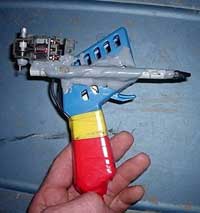Tattoo Supplies and Equipment
Despite the fact that it is sometimes attempted among certain segments of society tattooing is not something that can be done at home or with homemade tattoo equipment. Any professional tattoo artist or studio will have access to all the tattoo equipment needed to make sure that your tattoo experience is safe and relatively painless, and that the results are as you had imagined. Tattoos done with a handmade tattoo machine, as well as being unsafe, often have unattractive blurry edges. By contrast, professional tattoos have sharply defined lines and borders, and the designs themselves are often much more intricate.
Tattoo Supplies
For a professional tattoo, a whole range of tattoo supplies are needed, including a tattoo machine (sometimes called a tattoo gun), frames, coils, professional quality tattoo inks, and some medical supplies. To understand what all this tattoo equipment is and why it is needed, you need to understand the modern tattooing process.
The Tattoo Machine

A tattoo gun
Before the tattooing starts, the skin is cleaned off using special tattoo soap or alcohol soaked pads. Modern tattoo machines – sometimes called tattoo guns because of their gun-like appearance – are fitted with multiple needles soldered onto a bar. These needles are attached to coils or oscillating units, which move in and out of the skin very rapidly – anywhere from 50 to 3000 times a minute! This is the main reason why modern tattooing is a lot less painful than it was in the past – the needles move so quickly that you don’t feel each individual prick. Instead, most people experience a stinging sensation.
Tattoo machines or tattoo guns come in a variety of different styles and makes, though they all work on pretty much the same principle. They vary in price from around $60 to more than $300, with some vintage machines going for substantially more than that. A rotary tattoo machine is a solid choice, and about middle of the road in terms of price.
Tattoo Ink
The other essential component is, of course, tattoo ink. Today, tattoo inks are usually ordered from a supplier, and they come in about fourteen different colors. Temporary tattoo ink – which is not injected in the skin, but painted on for a temporary tattoo – comes in a similar range of colors, given that its purpose is to mimic the look of an actual tattoo. One modern – and sometimes controversial – choice is black light tattoo ink, which has a fluorescent glow that shows up in the dark. Originally used by marine biologists for tracking the migration patterns of sea creatures, black light tattoo ink was thought to be harmful to human health, and possibly radioactive. About ten years ago, some varieties received FDA approval.
Homemade Tattoos

A homemade tattoo gun
Instructions are available on the Internet about how to build a tattoo gun and how to make tattoo ink and other tattoo equipment. Generally speaking, for safety reasons this is not recommended, though it is a common practice in prisons, for example. The most common homemade tattoo ink is India ink; in a pinch, people have even used ink from a ballpoint pen. In some circles, sporting a homemade tattoo is a badge of honor, because it is a much more painful process than getting a professional tattoo. For most of us, though, a tattoo shop with professional tattoo equipment is a better choice.